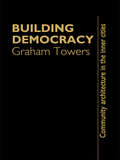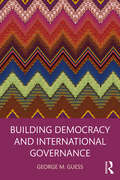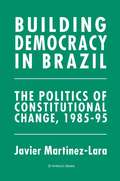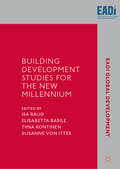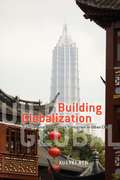- Table View
- List View
Building Cosmopolitan Communities: A Critical and Multidimensional Approach
by A. NascimentoBuilding Cosmopolitan Communities contributes to current cosmopolitanism debates by evaluating the justification and application of norms and human rights in different communitarian settings in order to achieve cosmopolitan ideals. Relying on a critical tradition that spans from Kant to contemporary discourse philosophy, Nascimento proposes the concept of a "multidimensional discourse community." The multidimensional model is applied and tested in various dialogues, resulting in a new cosmopolitan ideal based on a contemporary discursive paradigm. As the first scholarly text to provide an interdisciplinary survey of the theories and discourses on human rights and cosmopolitanism, Building Cosmopolitan Communities is a valuable resource to scholars of philosophy, political science, social theory, and globalization studies.
Building Decent Societies: Rethinking the Role of Social Security in Development
by P. TownsendThis book builds the case for a comprehensive social security system to be developed in all countries – to eliminate desperate conditions of poverty, reverse growing inequality and sustain economic growth. It gives the history of the rich countries in meeting poverty and shows how the strategies in the poor countries can be greatly improved.
Building Democracy
by Graham TowersBuilding Democracy is a major contribution to the growing public debate about the revival of community values in the face of the self-evident short-comings of the free market, specifically in terms of community architecture. Providing a historical context and an authoritative account of a movement that is proving surprisingly extensive and enduring, the book also examines the relevance of the approach to today's social and environmental problems, particularly in the inner cities. Community architecture was promoted in the early 1980s as the achievement of a handful of pioneering architects finding new ways of working with groups of ordinary people, to help them develop their own homes and community facilities. Building Democracy records the achievements of this movement and analyzes its contribution in addressing the problems of inner cities. Beginning with the origins of the urban question in the industrialization of the 19th century, the book goes on to look at the large-scale urban redevelopment of the 1960s - the latest and most concerted attempt to remodel Victorian cities, and on to community action, from which grew new approaches to design, development and construction. This book is of practical value to planners, architects, surveyors and landscape designers concerned with socially relevant design, as students or professionals. It will also be of interest to many people in the voluntary sector and in local government.
Building Democracy
by Graham TowersBuilding Democracy is a major contribution to the growing public debate about the revival of community values in the face of the self-evident short-comings of the free market, specifically in terms of community architecture. Providing a historical context and an authoritative account of a movement that is proving surprisingly extensive and enduring, the book also examines the relevance of the approach to today's social and environmental problems, particularly in the inner cities. Community architecture was promoted in the early 1980s as the achievement of a handful of pioneering architects finding new ways of working with groups of ordinary people, to help them develop their own homes and community facilities. Building Democracy records the achievements of this movement and analyzes its contribution in addressing the problems of inner cities. Beginning with the origins of the urban question in the industrialization of the 19th century, the book goes on to look at the large-scale urban redevelopment of the 1960s - the latest and most concerted attempt to remodel Victorian cities, and on to community action, from which grew new approaches to design, development and construction. This book is of practical value to planners, architects, surveyors and landscape designers concerned with socially relevant design, as students or professionals. It will also be of interest to many people in the voluntary sector and in local government.
Building Democracy and International Governance
by George M. GuessEfforts by governments to promote sustained domestic economic development have been mixed. Success depends on many factors including location, geography, climate, external competition, human resources, natural resources, timing, political and governmental institutions, government capacity, implementation, leadership, values—and maybe luck. This complexity means that while development experts can often identify ingredients for success, few can prescribe the specific mix needed by a particular state to achieve sustained development over the long term. In Building Democracy and International Governance, author George M. Guess uses both case studies and careful data analysis to argue that federalist democracy may just be the most responsive, authoritative, and flexible system for nation building, and that there is value in confronting the challenges that lie in exporting federalist democracy abroad. Guess demonstrates the ways in which federation structures provide positive redundancy against failures, flexibility to change course and implement programs and policies, and state legitimacy and strength. Examining twelve wealthy and developing countries from five regions, representing democratic and authoritarian government structures, confederations, and federations, this book will be of interest to those teaching graduate and undergraduate courses in Political Development, Democratization, Federalism, and Comparative Political Economy.
Building Democracy and International Governance
by George M. GuessEfforts by governments to promote sustained domestic economic development have been mixed. Success depends on many factors including location, geography, climate, external competition, human resources, natural resources, timing, political and governmental institutions, government capacity, implementation, leadership, values—and maybe luck. This complexity means that while development experts can often identify ingredients for success, few can prescribe the specific mix needed by a particular state to achieve sustained development over the long term. In Building Democracy and International Governance, author George M. Guess uses both case studies and careful data analysis to argue that federalist democracy may just be the most responsive, authoritative, and flexible system for nation building, and that there is value in confronting the challenges that lie in exporting federalist democracy abroad. Guess demonstrates the ways in which federation structures provide positive redundancy against failures, flexibility to change course and implement programs and policies, and state legitimacy and strength. Examining twelve wealthy and developing countries from five regions, representing democratic and authoritarian government structures, confederations, and federations, this book will be of interest to those teaching graduate and undergraduate courses in Political Development, Democratization, Federalism, and Comparative Political Economy.
Building Democracy in Brazil: The Politics of Constitutional Change, 1985-95 (St Antony's Series)
by Javier Martínez-LaraBuilding Democracy in Brazil is an empirical analysis of the constitution-making process that Brazil underwent in the 1980s as it moved from an authoritarian military regime to a democratic civilian government. The study explores the institutional and political context from which the process departed as well as the choices of the key social and political actors. It then examines in depth the different stages of the constitutional elaboration.
Building Development Studies for the New Millennium (EADI Global Development Series)
by Isa Baud Elisabetta Basile Tiina Kontinen Susanne Von ItterThis book brings together multiple critical assessments of the current state and future visions of global development studies. It examines how the field engages with new paradigms and narratives, methodologies and scientific impact, and perspectives from the Global South. The authors focus on social and democratic transformation, inclusive development and global environmental issues, and implications for research practices. Leading academics provide an excellent overview of recent insights for post-graduate students and scholars in these research areas.
Building Digital Government Strategies: Principles and Practices (Public Administration and Information Technology #16)
by Rodrigo Sandoval-Almazán Luis F. Luna-Reyes Dolores E. Luna-Reyes J. Ramon Gil-Garcia Gabriel Puron-Cid Sergio Picazo-VelaThis book provides key strategic principles and best practices to guide the design and implementation of digital government strategies. It provides a series of recommendations and findings to think about IT applications in government as a platform for information, services and collaboration, and strategies to avoid identified pitfalls. Digital government research suggests that information technologies have the potential to generate immense public value and transform the relationships between governments, citizens, businesses and other stakeholders. However, developing innovative and high impact solutions for citizens hinges on the development of strategic institutional, organizational and technical capabilities. Thus far, particular characteristics and problems of the public sector organization promote the development of poorly integrated and difficult to maintain applications. For example, governments maintain separate applications for open data, transparency, and public services, leading to duplication of efforts and a waste of resources. The costs associated with maintaining such sets of poorly integrated systems may limit the use of resources to future projects and innovation. This book provides best practices and recommendations based on extensive research in both Mexico and the United States on how governments can develop a digital government strategy for creating public value, how to finance digital innovation in the public sector, how to building successful collaboration networks and foster citizen engagement, and how to correctly implement open government projects and open data. It will be of interest to researchers, practitioners, students, and public sector IT professionals that work in the design and implementation of technology-based projects and programs.
Building Entrepreneurial Ecosystems in Sub-Saharan Africa: A Quintuple Helix Model (Palgrave Studies of Entrepreneurship in Africa)
by Constant D. BeugréAfrica suffers from two main diseases: poor management and a lack of vibrant entrepreneurial activity. The continent has the raw materials, the people, and the potential to be developed, and yet there remain barriers that prevent it from bettering itself. To promote entrepreneurship as an engine of economic development and growth, the author has developed a Quintuple Helix Model which advocates mutual cooperation and information sharing among the five helices and provides valuable guidelines to policymakers on how to build entrepreneurship ecosystems in sub-Saharan Africa. It goes on to examine the roles that government, donors, and public and private sectors play and how Africans themselves might take the development of entrepreneurial societies into their own hands. The book includes seven chapters that emphasize the key role that each of the five components could play in the development of entrepreneurial ecosystems. Entrepreneurship scholars, policy makers, and national and local governments of sub-Saharan Africa will value this insight as they strive to create a more favorable landscape for their citizenry.
Building Environmental Peace: The UN Environment Programme as a Knowledge Actor
by Natalia DalmerBy analyzing the UN Environment Programme’s (UNEP’s) contribution to peacebuilding, this book aims to show how international bureaucracies develop knowledge and thereby come to matter on the world stage. Portraying UNEP as an open system, it explores how a growing understanding within the Programme of how environmental degradation shapes insecurities and vice versa has motivated its work on peacebuilding. The theoretical part of this book addresses knowledge, open systems, and knowledge creation. It then presents a historical discussion of UNEP’s development in an open system context. Finally, it investigates how knowledge emergence on the linkage between the environment, conflicts, and insecurities influenced UNEP’s interests and its work on environmental peacebuilding.
Building EU Regulatory Capacity: The Work of Under-Resourced Agencies in the European Union (Executive Politics and Governance)
by Eva HeimsThis book examines regulatory capacity beyond the nation state. It suggests that we can only understand why EU agencies are able to build EU regulatory capacity if we acknowledge that national regulators provide their expertise, staff and resources to the regulatory processes taking place in these EU bodies. This raises the puzzle of why national regulators are willing to provide ‘life support’ to potentially rival organisations. The book is devoted to answering this question in order to understand how EU regulatory capacity is created in the absence of a full supranational regulatory bureaucracy. To do so, the book studies to what extent national regulators from two countries (the UK and Germany) support EU agencies in their work across four policy sectors (drug safety, food safety, maritime safety and banking supervision). The book makes a significant contribution by developing a bureaucratic politics perspective that highlights the importance of national regulators for EU regulatory capacity building.
Building Evidence for Active Ageing Policies: Active Ageing Index And Its Potential
by Sarah Harper Asghar Zaidi Kenneth Howse Giovanni Lamura Jolanta Perek-BiałasThis book provides multinational evidence on active and healthy ageing. It generates authoritative new knowledge for mutual learning and policymaking in addressing challenges linked with population ageing. The authors discuss how to achieve better active ageing outcomes through appropriate policies including addressing life course determinants of active and healthy ageing. The chapters are distinctive in their focus on quantitative analysis of active and healthy ageing based on a first-of-its-kind composite measure, the Active Ageing Index developed during the 2012 European Year for Active Ageing and Solidarity between Generations. Contributors include researchers, civil service representatives, policymakers and other stakeholders from national, regional and European organisations. This edited volume provides a multidisciplinary resource for academics and policy makers in various areas of the social sciences, especially those studying population ageing and its consequences, economists, sociologists, social policy analysts and public health experts.
Building Evidence for Active Ageing Policies: Active Ageing Index and its Potential
by Sarah Harper Asghar Zaidi Kenneth Howse Giovanni Lamura Jolanta Perek-BiałasThis book provides multinational evidence on active and healthy ageing. It generates authoritative new knowledge for mutual learning and policymaking in addressing challenges linked with population ageing. The authors discuss how to achieve better active ageing outcomes through appropriate policies including addressing life course determinants of active and healthy ageing. The chapters are distinctive in their focus on quantitative analysis of active and healthy ageing based on a first-of-its-kind composite measure, the Active Ageing Index developed during the 2012 European Year for Active Ageing and Solidarity between Generations. Contributors include researchers, civil service representatives, policymakers and other stakeholders from national, regional and European organisations. This edited volume provides a multidisciplinary resource for academics and policy makers in various areas of the social sciences, especially those studying population ageing and its consequences, economists, sociologists, social policy analysts and public health experts.
Building Excellence in Higher Education: Singapore’s Experience
by Arnoud De Meyer Jovina AngOver the last 30 years, Singapore has developed a system of higher education that is the envy of many other countries and regions. How has Singapore developed such a highly performing education system? Was it planned? Was it mere luck? Written by Arnoud De Meyer, who is widely regarded as one of the pre-eminent management educators and leaders in higher education, the book focuses on Singapore as an in-depth case study of how to build a system of higher education, and specifically a portfolio of highly differentiated and diversified universities. He worked closely together with Jovina Ang during the preparation of the manuscript. This book is unique because it showcases several case studies of the emerging system of higher education, and it was written based on insights drawn from interviews with the key decision-makers and actors in the system from the past 20 years, including ministers and permanent secretaries of the Ministry of Education, and presidents and chairmen of the six universities. The success of this system can be attributed to several factors: the clarity of purpose of the decision-makers, with clear targets in cohort participation rate, commitment to significant funding for education and research, discipline of an intelligent and well-implemented governance system, flexibility in adjusting plans, and rapid and adaptive learning from overseas partners. In the last few chapters, the authors look at the future of the system and postulate how it should be adjusted to the changes in Singapore and the world. This unique book on educational strategy would be of particular interest to educational specialists and policy-makers in emerging countries who want to build a system of higher education, policy-makers in mature industrialised countries who are faced with the challenge of revamping their system of higher education, strategists who are interested in dynamic capability building and philanthropists who want to use education as an equaliser of social status.
Building Excellence in Higher Education: Singapore’s Experience
by Arnoud De Meyer Jovina AngOver the last 30 years, Singapore has developed a system of higher education that is the envy of many other countries and regions. How has Singapore developed such a highly performing education system? Was it planned? Was it mere luck? Written by Arnoud De Meyer, who is widely regarded as one of the pre-eminent management educators and leaders in higher education, the book focuses on Singapore as an in-depth case study of how to build a system of higher education, and specifically a portfolio of highly differentiated and diversified universities. He worked closely together with Jovina Ang during the preparation of the manuscript. This book is unique because it showcases several case studies of the emerging system of higher education, and it was written based on insights drawn from interviews with the key decision-makers and actors in the system from the past 20 years, including ministers and permanent secretaries of the Ministry of Education, and presidents and chairmen of the six universities. The success of this system can be attributed to several factors: the clarity of purpose of the decision-makers, with clear targets in cohort participation rate, commitment to significant funding for education and research, discipline of an intelligent and well-implemented governance system, flexibility in adjusting plans, and rapid and adaptive learning from overseas partners. In the last few chapters, the authors look at the future of the system and postulate how it should be adjusted to the changes in Singapore and the world. This unique book on educational strategy would be of particular interest to educational specialists and policy-makers in emerging countries who want to build a system of higher education, policy-makers in mature industrialised countries who are faced with the challenge of revamping their system of higher education, strategists who are interested in dynamic capability building and philanthropists who want to use education as an equaliser of social status.
Building for a Sustainable Future in Our Schools: Brick by Brick
by Rosemary Papa Anna SaitiThis book explores how educators can transform improvements from the dynamic process of teaching into far-reaching, sustainable reforms that can secure a more prosperous future for students and the world they inhabit. It establishes the role of leadership in educational sustainability and highlights methods of creating sustainable educational reforms. The authors emphasize the importance of implementing ethical and moral values in teaching sustainable practices, and discuss the critical relationship between the classroom and the local community and policies protecting planet earth. Furthermore, through the inclusion of research and case studies drawn from countries across the world, this valuable resource demonstrates how transformational leadership practices can contribute to a culture of sustainability in all classrooms, pre-K through university.Among the topics covered:- Social Capital Dimensions: Social Justice, Morality, and the Common Good- Classroom and Community Partners: The Ethics and Morality Inherent in Sustainable Practices- Developing a Culture for Sustainability in Educational Organisations and in Partnerships, i.e., Across Disciplines and Communities- Understanding Leadership Practices in a Sustainable School Model: A Case Study from TurkeyEducators, education researchers, and policymakers in education will findBuilding for a Sustainable Future in Our Schools: Brick by Brick to be a useful tool in understanding the critical role of education in sustainable development encouraging complementary relationships between humans and our earth.
Building Global Democracy?: Civil Society and Accountable Global Governance (PDF)
by Editor Jan Aart ScholteThe scale, effectiveness and legitimacy of global governance lag far behind the world's needs. This path-breaking book examines how far civil society involvement provides an answer to these problems. Does civil society make global governance more democratic? Have citizen action groups raised the accountability of global bodies that deal with challenges such as climate change, financial crises, conflict, disease and inequality? What circumstances have promoted (or blocked) civil society efforts to make global governance institutions more democratically accountable? What could improve these outcomes in the future? The authors base their argument on studies of thirteen global institutions, including the UN, G8, WTO, ICANN and IMF. Specialists from around the world critically assess what has and has not worked in efforts to make global bodies answer to publics as well as states. Combining intellectual depth and political relevance, Building Global Democracy? will appeal to students, researchers, activists and policymakers.
Building Global Education with a Local Perspective: An Introduction to Glocal Higher Education
by Emmanuel Jean Francois"Glocal" education melds the economic advantages of globalizing higher education with the benefits of incorporating local perspectives. This book explores glocal education's rationale; social, cultural, and economic foundations; key concepts; and implementation.
Building Global Infrastructure
by Dale S. Rothman Mohammod T. Irfan Barry B. Hughes Eli Margolese-Malin Jonathan D. MoyerBuilding Global Infrastructure is the fourth in a series of volumes-Patterns of Potential Human Progress-that uses the International Futures (IFs) simulation model to explore prospects for human development: how development appears to be unfolding globally and locally, how we would like it to evolve, and how better to assure that we move it in desired directions. Earlier volumes addressed the reduction of global poverty, the advance of global education, and the improvement of global health. Volume 4 sets out to tell the story of the future of global infrastructure. The approach used in this book focuses on the question of whether individual societies will be able to meet future infrastructure demands. Related questions include the following: * What is the range of realistically conceivable futures for infrastructure, considering both demand and supply? * How are the demands for infrastructure balanced with the ability to meet these demands, thereby linking the physical and financial treatment of infrastructure? * What are the effects of providing for infrastructure on issues such as economic productivity and health?
Building Global Infrastructure
by Dale S. Rothman Mohammod T. Irfan Barry B. Hughes Eli Margolese-Malin Jonathan D. MoyerBuilding Global Infrastructure is the fourth in a series of volumes-Patterns of Potential Human Progress-that uses the International Futures (IFs) simulation model to explore prospects for human development: how development appears to be unfolding globally and locally, how we would like it to evolve, and how better to assure that we move it in desired directions. Earlier volumes addressed the reduction of global poverty, the advance of global education, and the improvement of global health. Volume 4 sets out to tell the story of the future of global infrastructure. The approach used in this book focuses on the question of whether individual societies will be able to meet future infrastructure demands. Related questions include the following: * What is the range of realistically conceivable futures for infrastructure, considering both demand and supply? * How are the demands for infrastructure balanced with the ability to meet these demands, thereby linking the physical and financial treatment of infrastructure? * What are the effects of providing for infrastructure on issues such as economic productivity and health?
Building Globalization: Transnational Architecture Production in Urban China
by Xuefei RenFrom the years 2004 to 2008, Beijing and Shanghai witnessed the construction of an extraordinary number of new buildings, many of which were designed by architectural firms overseas. Combining ethnographic fieldwork, historical research, and network analysis, Building Globalization closely scrutinizes the growing phenomenon of transnational architecture and its profound effect on the development of urban space. Roaming from construction sites in Shanghai to architects’ offices in Paris, Xuefei Ren interviews hundreds of architects, developers, politicians, residents, and activists to explore this issue. She finds that in the rapidly transforming cities of modern China, iconic designs from prestigious international architects help private developers to distinguish their projects, government officials to advance their careers, and the Chinese state to announce the arrival of modern China on the world stage. China leads the way in the globalization of architecture, a process whose ramifications can be felt from Beijing to Dubai to Basel. Connecting the dots between real estate speculation, megaproject construction, residential displacement, historical preservation, housing rights, and urban activism, Building Globalization reveals the contradictions and consequences of this new, global urban frontier.
Building Globalization: Transnational Architecture Production in Urban China
by Xuefei RenFrom the years 2004 to 2008, Beijing and Shanghai witnessed the construction of an extraordinary number of new buildings, many of which were designed by architectural firms overseas. Combining ethnographic fieldwork, historical research, and network analysis, Building Globalization closely scrutinizes the growing phenomenon of transnational architecture and its profound effect on the development of urban space. Roaming from construction sites in Shanghai to architects’ offices in Paris, Xuefei Ren interviews hundreds of architects, developers, politicians, residents, and activists to explore this issue. She finds that in the rapidly transforming cities of modern China, iconic designs from prestigious international architects help private developers to distinguish their projects, government officials to advance their careers, and the Chinese state to announce the arrival of modern China on the world stage. China leads the way in the globalization of architecture, a process whose ramifications can be felt from Beijing to Dubai to Basel. Connecting the dots between real estate speculation, megaproject construction, residential displacement, historical preservation, housing rights, and urban activism, Building Globalization reveals the contradictions and consequences of this new, global urban frontier.
Building Globalization: Transnational Architecture Production in Urban China
by Xuefei RenFrom the years 2004 to 2008, Beijing and Shanghai witnessed the construction of an extraordinary number of new buildings, many of which were designed by architectural firms overseas. Combining ethnographic fieldwork, historical research, and network analysis, Building Globalization closely scrutinizes the growing phenomenon of transnational architecture and its profound effect on the development of urban space. Roaming from construction sites in Shanghai to architects’ offices in Paris, Xuefei Ren interviews hundreds of architects, developers, politicians, residents, and activists to explore this issue. She finds that in the rapidly transforming cities of modern China, iconic designs from prestigious international architects help private developers to distinguish their projects, government officials to advance their careers, and the Chinese state to announce the arrival of modern China on the world stage. China leads the way in the globalization of architecture, a process whose ramifications can be felt from Beijing to Dubai to Basel. Connecting the dots between real estate speculation, megaproject construction, residential displacement, historical preservation, housing rights, and urban activism, Building Globalization reveals the contradictions and consequences of this new, global urban frontier.
Building Globalization: Transnational Architecture Production in Urban China
by Xuefei RenFrom the years 2004 to 2008, Beijing and Shanghai witnessed the construction of an extraordinary number of new buildings, many of which were designed by architectural firms overseas. Combining ethnographic fieldwork, historical research, and network analysis, Building Globalization closely scrutinizes the growing phenomenon of transnational architecture and its profound effect on the development of urban space. Roaming from construction sites in Shanghai to architects’ offices in Paris, Xuefei Ren interviews hundreds of architects, developers, politicians, residents, and activists to explore this issue. She finds that in the rapidly transforming cities of modern China, iconic designs from prestigious international architects help private developers to distinguish their projects, government officials to advance their careers, and the Chinese state to announce the arrival of modern China on the world stage. China leads the way in the globalization of architecture, a process whose ramifications can be felt from Beijing to Dubai to Basel. Connecting the dots between real estate speculation, megaproject construction, residential displacement, historical preservation, housing rights, and urban activism, Building Globalization reveals the contradictions and consequences of this new, global urban frontier.


